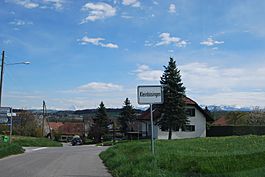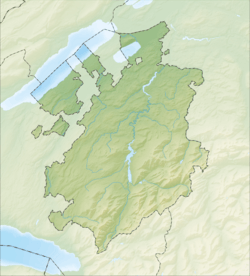Kleinbösingen facts for kids
Quick facts for kids
Kleinbösingen
|
||
|---|---|---|
 |
||
|
||
| Country | Switzerland | |
| Canton | Fribourg | |
| District | See | |
| Area | ||
| • Total | 3.02 km2 (1.17 sq mi) | |
| Elevation | 509 m (1,670 ft) | |
| Population
(Dec 2020 )
|
||
| • Total | 699 | |
| • Density | 231.5/km2 (599.5/sq mi) | |
| Postal code |
3213
|
|
| Surrounded by | Bösingen, Düdingen, Gurmels, Kriechenwil (BE) | |
Kleinbösingen is a small town, also called a municipality, located in the See district of Switzerland. It is part of the canton of Fribourg. Even though Fribourg canton mostly speaks French, Kleinbösingen has many German speakers. Its old French name was Petit-Basens.
Contents
A Look at Kleinbösingen's Past
Kleinbösingen has a long history. It was first mentioned in official papers in 1264. Back then, it was known as Balsingen lo pitet. Later, it was called Besingen in 1264-65. In 1584, its name changed to Zänerbösingen. Up until the 1700s, it was also known as Welschbösingen.
Exploring Kleinbösingen's Geography
Kleinbösingen covers an area of about 3.01 square kilometers. A big part of this land, about 64.8%, is used for farming. This means fields for crops and pastures for animals. Forests cover about 20.9% of the area.
About 9.3% of the land is built up with buildings and roads. Rivers and lakes make up about 2.7% of the area. A small part, 2.3%, is land that cannot be used for farming or building.
The town is located in the See district. It sits on the left side of the Saane/Sarine river. It is also found at the end of the Schiffenensee lake. This area is between the towns of Murten and Fribourg.
Understanding the Kleinbösingen Coat of Arms
Every town has a special symbol called a coat of arms. It tells a story about the place. Kleinbösingen's coat of arms is split into two parts. The top part is red and shows a bull walking. The bottom part is silver and has a blue plowshare. A plowshare is the sharp part of a plow used for farming.
People and Population in Kleinbösingen
Kleinbösingen has a population of about 582 people as of 2010. A small part of the population, about 7.1%, are people from other countries. Over the last 10 years (2000-2010), the number of people living here grew by 15%. Most of this growth was because people moved here.
Languages Spoken in Kleinbösingen
Most people in Kleinbösingen speak German. About 94.9% of the population uses German as their main language. French is the second most common language, spoken by 3.0% of people. A small number, 1.2%, speak Italian.
Who Lives in Kleinbösingen?
In 2008, the population was almost evenly split between males and females. About 49.8% were male and 50.2% were female. Most people living in Kleinbösingen were born in Switzerland. About 27.5% were born right in Kleinbösingen. Another 26.7% were born in the same canton of Fribourg.
When looking at age groups in 2000:
- Kids and teenagers (0–19 years old) made up 26.3% of the population.
- Adults (20–64 years old) made up 66.6%.
- Seniors (over 64 years old) made up 7.1%.
Homes and Households in Kleinbösingen
In 2000, there were 181 private homes in Kleinbösingen. On average, about 2.8 people lived in each home. Some homes had only one person, while 17 homes had five or more people. Most apartments, 93%, were lived in all the time. A small number were used only during certain seasons or were empty.
The chart below shows how Kleinbösingen's population has changed over many years:

Kleinbösingen's Economy and Jobs
In 2010, the unemployment rate in Kleinbösingen was very low, at 1.1%. This means almost everyone who wanted a job had one.
Types of Jobs in Kleinbösingen
Jobs are often grouped into three main types:
- Primary sector: These jobs involve getting raw materials from nature. In Kleinbösingen, 19 people worked in this sector, mostly in agriculture (farming).
- Secondary sector: These jobs involve making things from raw materials. In Kleinbösingen, 29 people worked in this sector. This included jobs in manufacturing (making goods) and construction (building things).
- Tertiary sector: These jobs involve providing services to people. In Kleinbösingen, 37 people worked in this sector. Many worked in sales, retail, or repairing vehicles. Others worked in transportation or as scientists.
In 2008, there were 67 full-time jobs in Kleinbösingen. Many people who live in Kleinbösingen travel to other towns for work. About 10.2% used public transportation, and 74.4% drove their own cars.
Religion in Kleinbösingen
Based on information from 2000, about 50.8% of the people in Kleinbösingen were Roman Catholic. Another 35.0% belonged to the Swiss Reformed Church. A smaller number of people belonged to other Christian churches. There were also a few people who were Islamic, Buddhist, or Hindu. About 8.1% of the population did not belong to any church.
Education in Kleinbösingen
Education is very important in Switzerland. In Kleinbösingen, about 38.7% of adults have finished upper secondary education. This is like high school. About 13.2% have gone on to higher education, like university.
The Fribourg School System
The school system in Fribourg canton works like this:
- Kids start with one year of non-required Kindergarten.
- Then they go to six years of Primary school.
- After that, there are three years of required lower Secondary school. Students are grouped by their abilities.
- Next, students can choose to go to an optional three or four-year upper Secondary school. This can be a gymnasium (which prepares them for university) or a vocational program (which teaches job skills).
- After upper Secondary, students can go to a Tertiary school (like a university) or continue with an apprenticeship to learn a trade.
In the 2010-2011 school year, no students attended school right in Kleinbösingen. However, 86 students from Kleinbösingen went to schools in nearby towns. These included students in kindergarten, primary school, secondary school, and vocational programs.
See also

- In Spanish: Kleinbösingen para niños




